Abstract
Both the inhibitory effect of aphidicolin on the replicative alpha-polymerase and the reversibility of its action in vivo (Pedrali-Noy & Spadari, 1979, Biochem. Biophys. Res. Commun. 88, 1194-2002) allow the synchronization of cells in culture. Aphidicolin prevents G1 cells from entering the DNA synthetic period, blocks cells in "S" phase, allows G2, M and G1 cells to continue the cell cycle and to accumulate at the G1/S border. Aphidicolin is a more useful reagent than hydroxyurea and thymidine because it does not affect cell viability or "S" phase duration and does not interfere with the synthesis of dNTPs or DNA polymerases. In fact cells exposed to the drug continue to synthesize all three DNA polymerases alpha, beta and gamma as well as all dNTPs which, when the block is removed, are present at levels optimal for DNA initiation and replication. The technique is simple and can be applied to cells growing in suspension or monolayers and allows one to harvest large quantities of synchronized cells.
Full text
PDF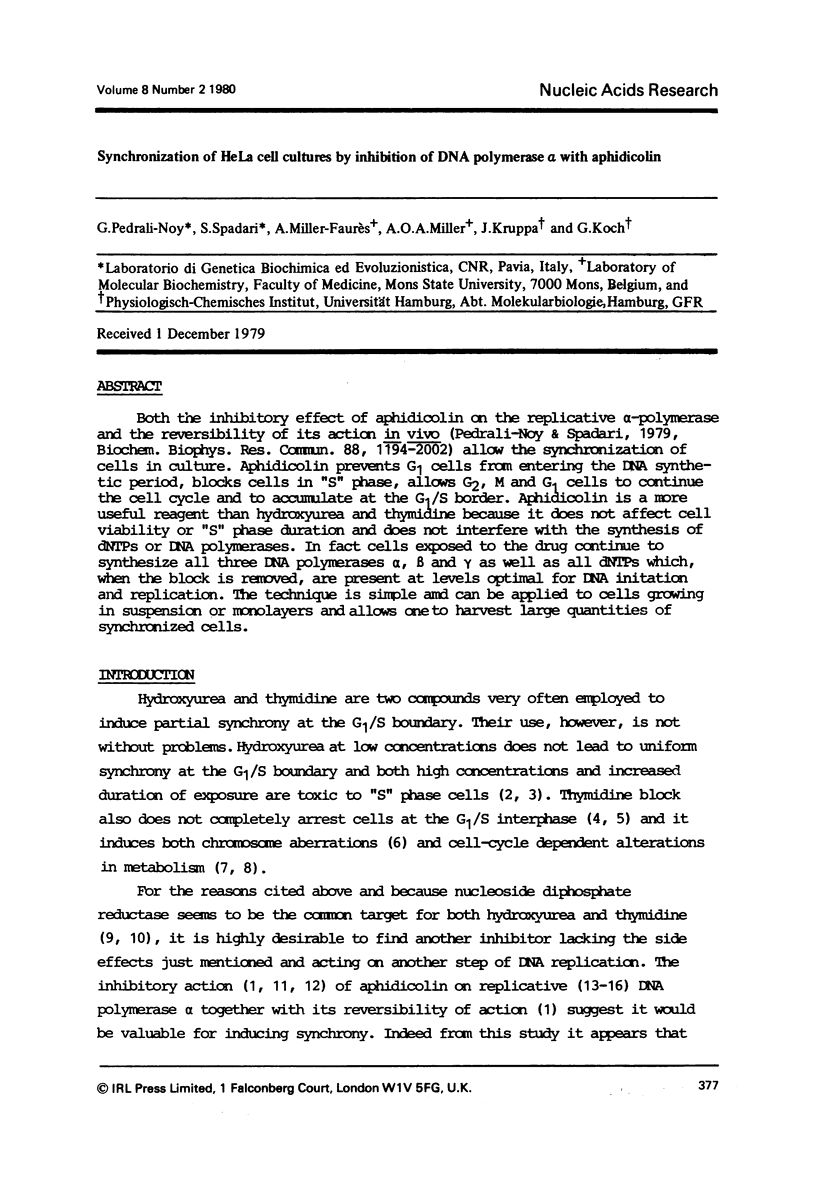
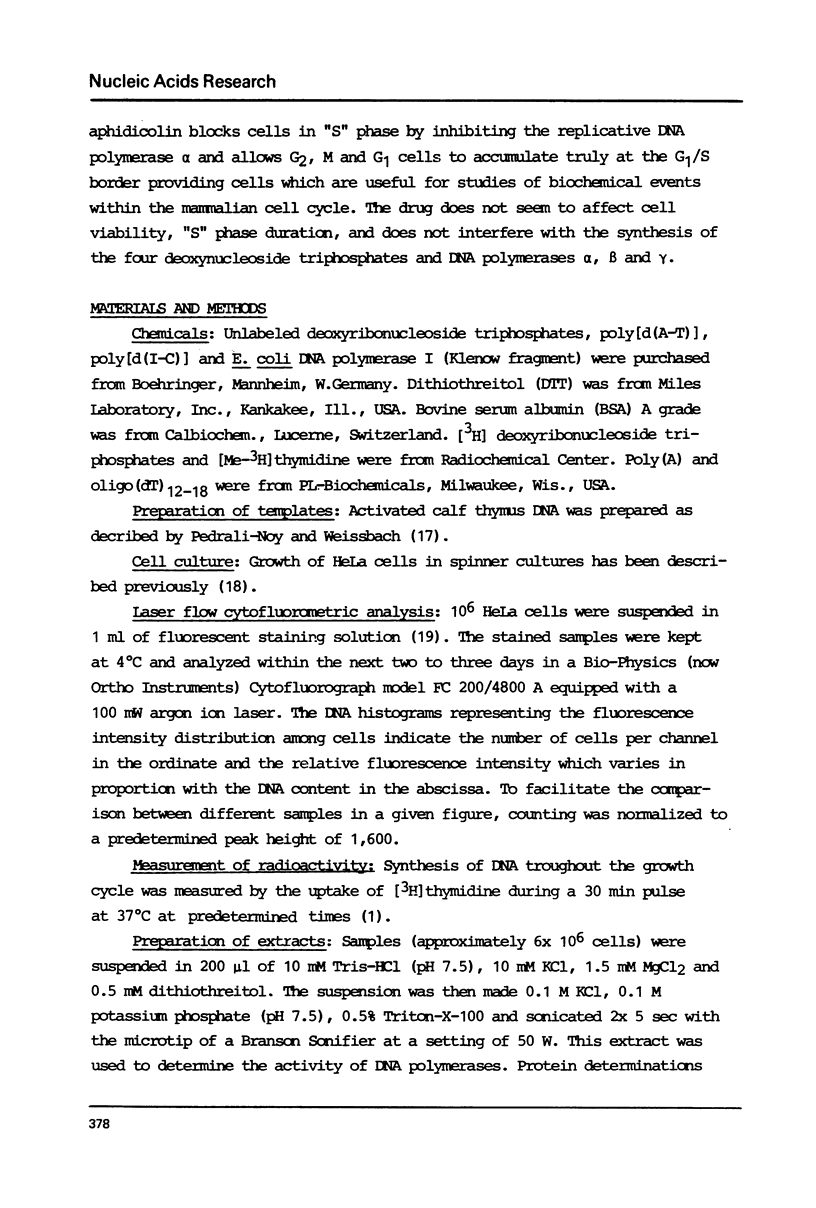
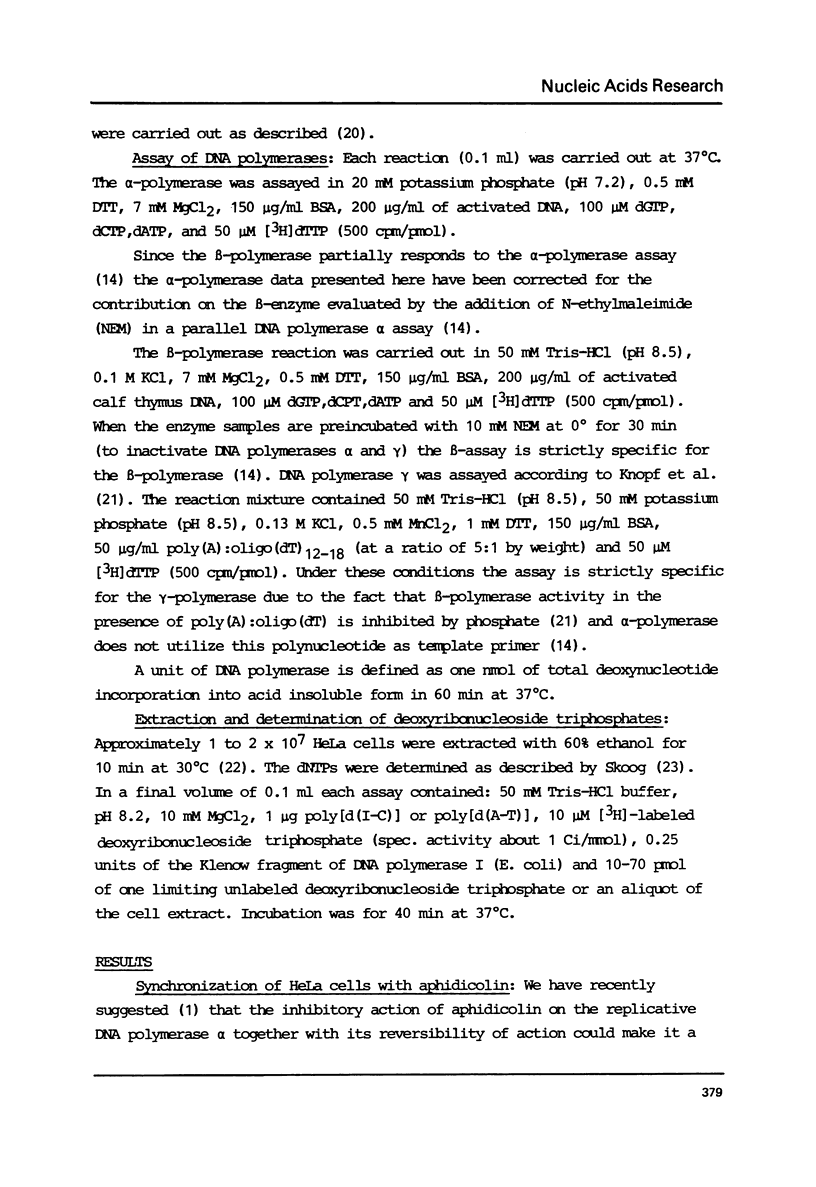
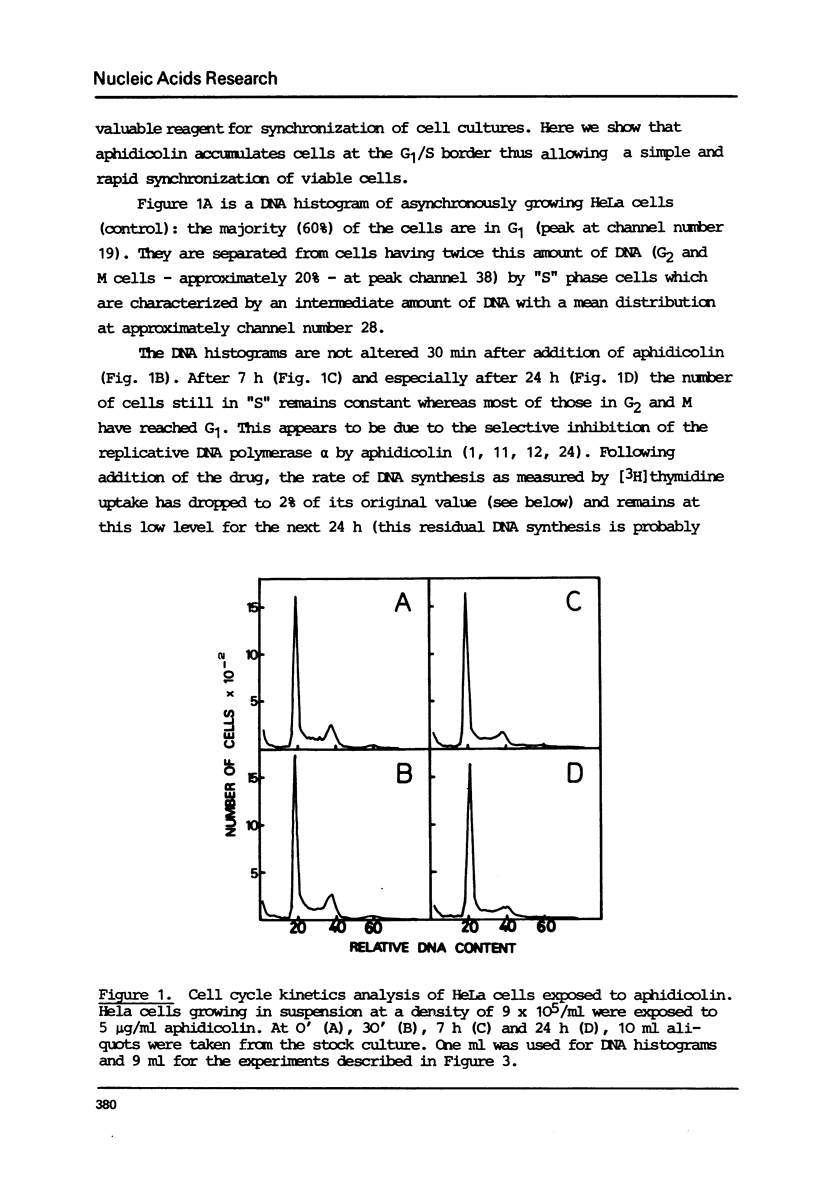
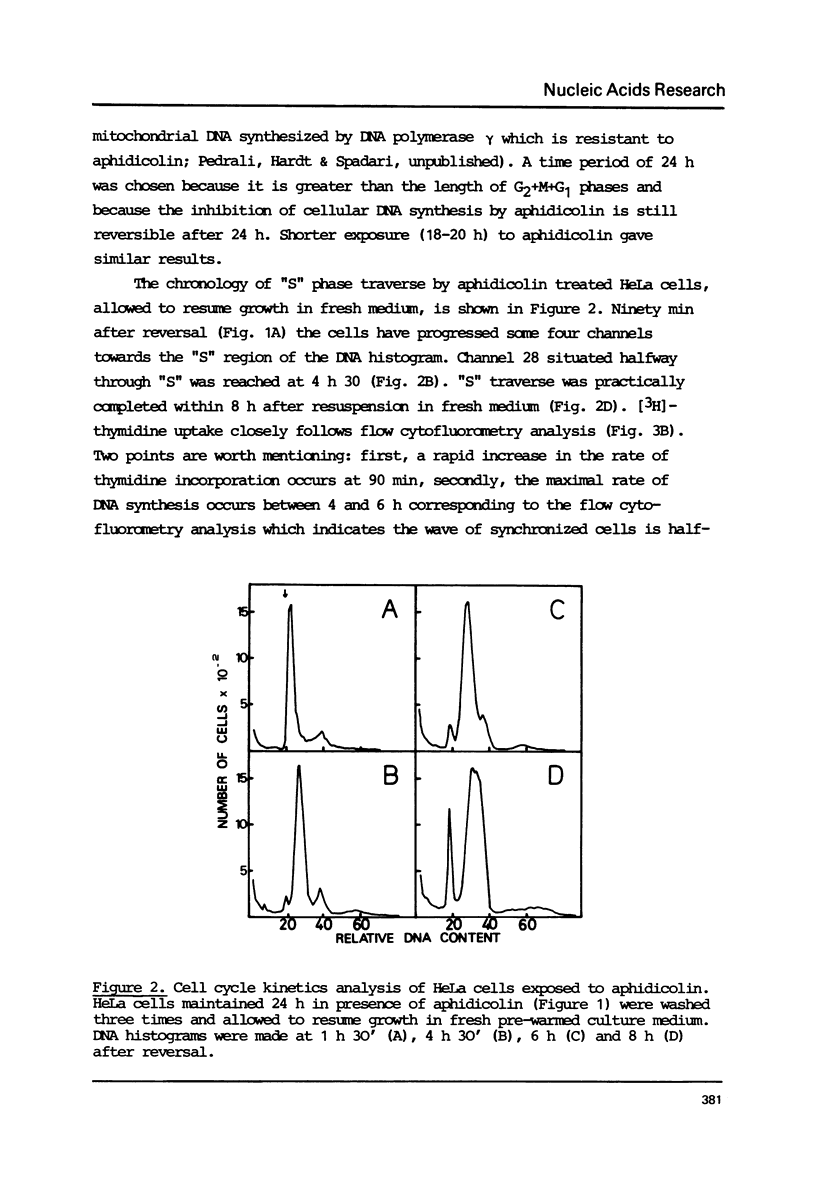
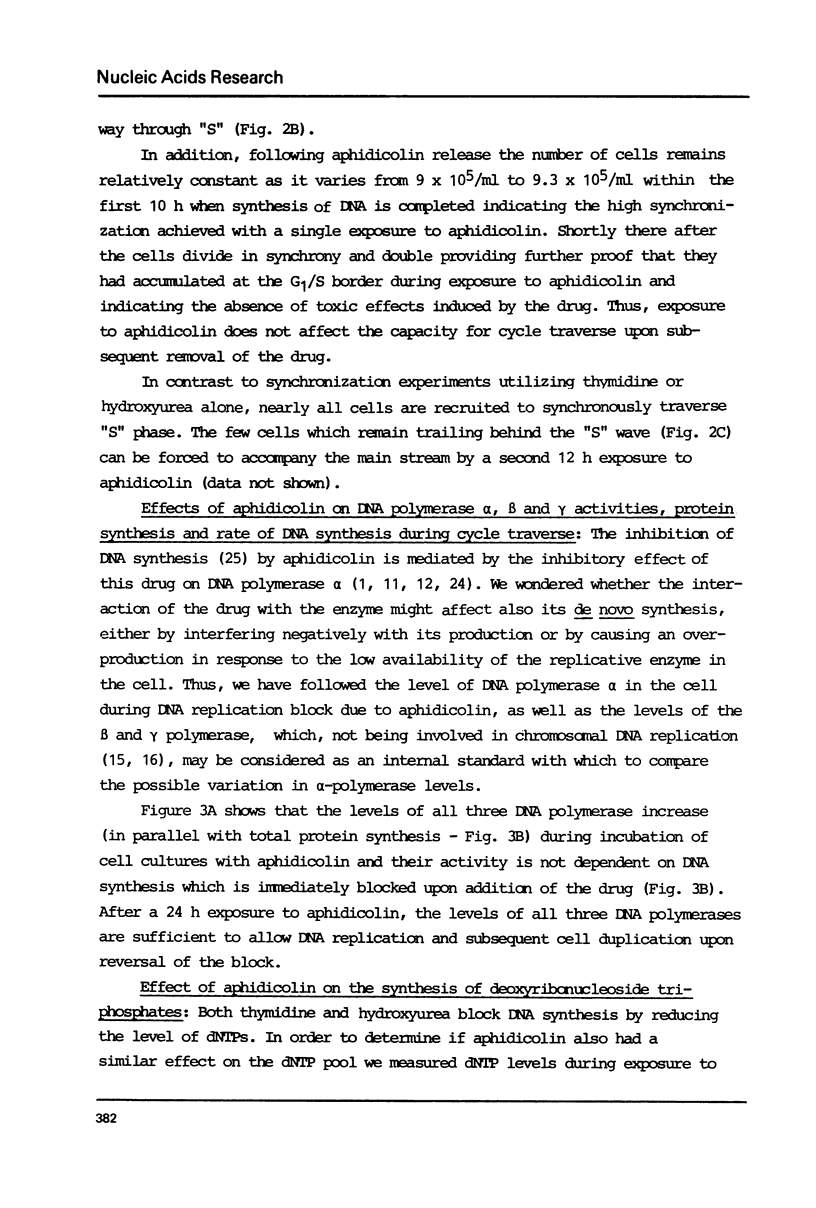
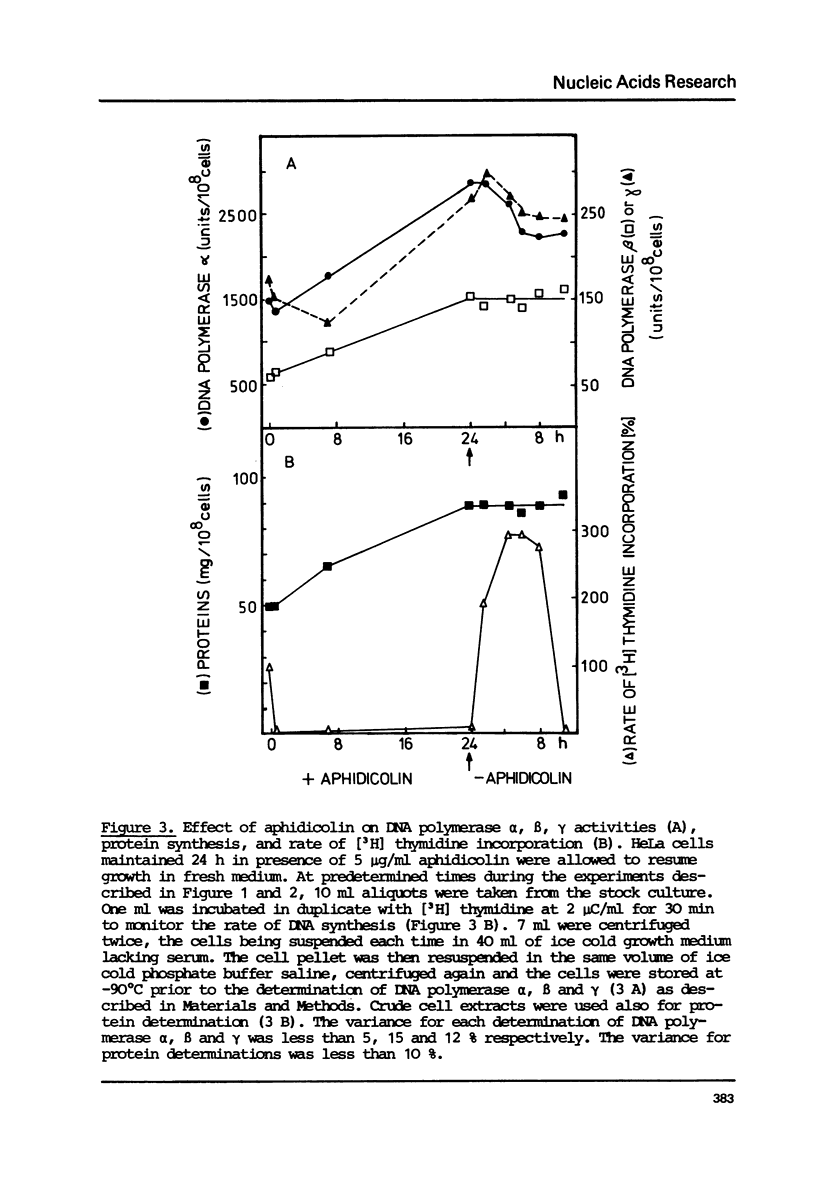
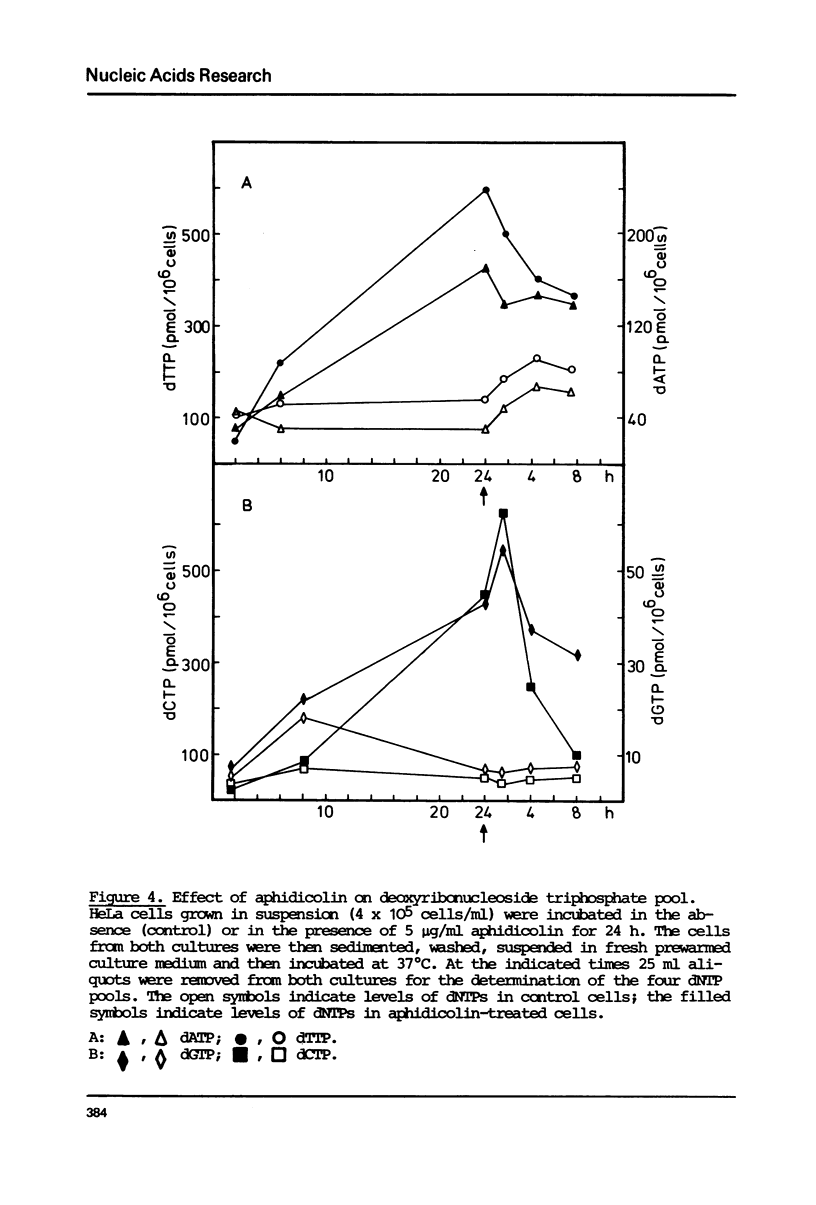
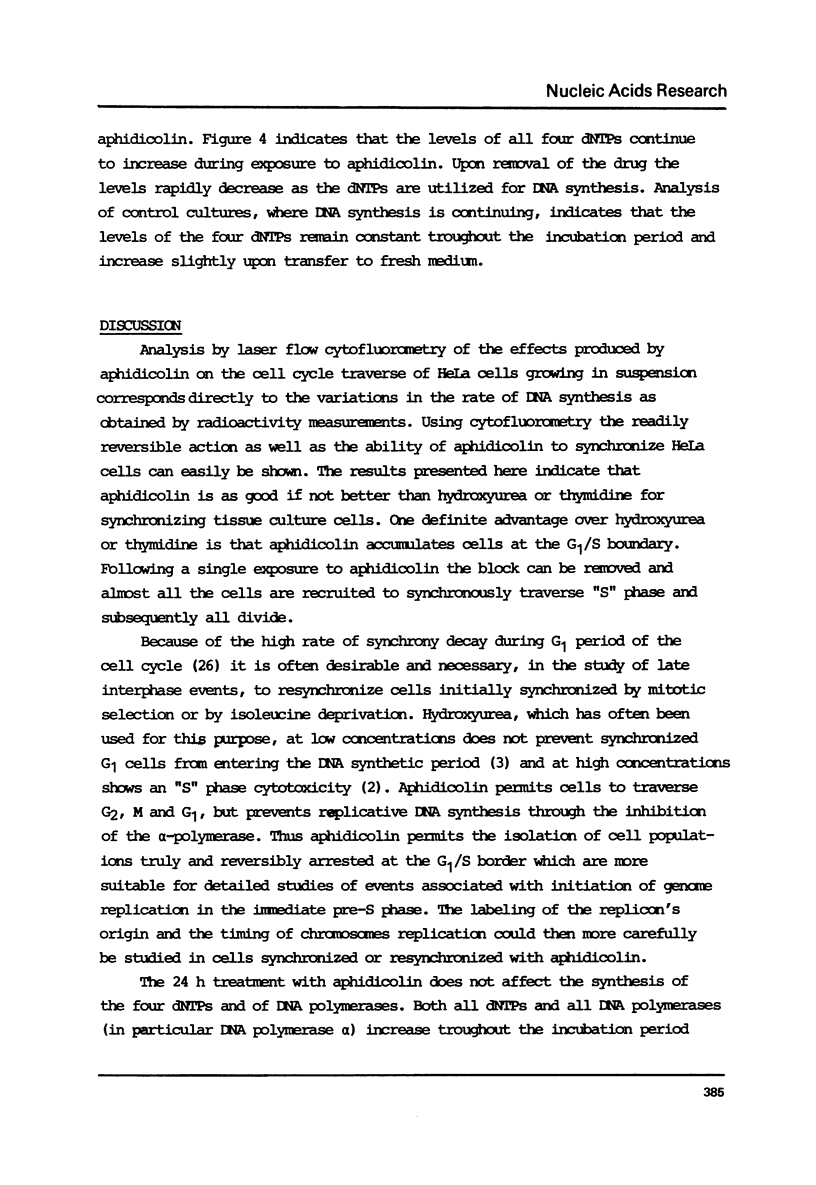
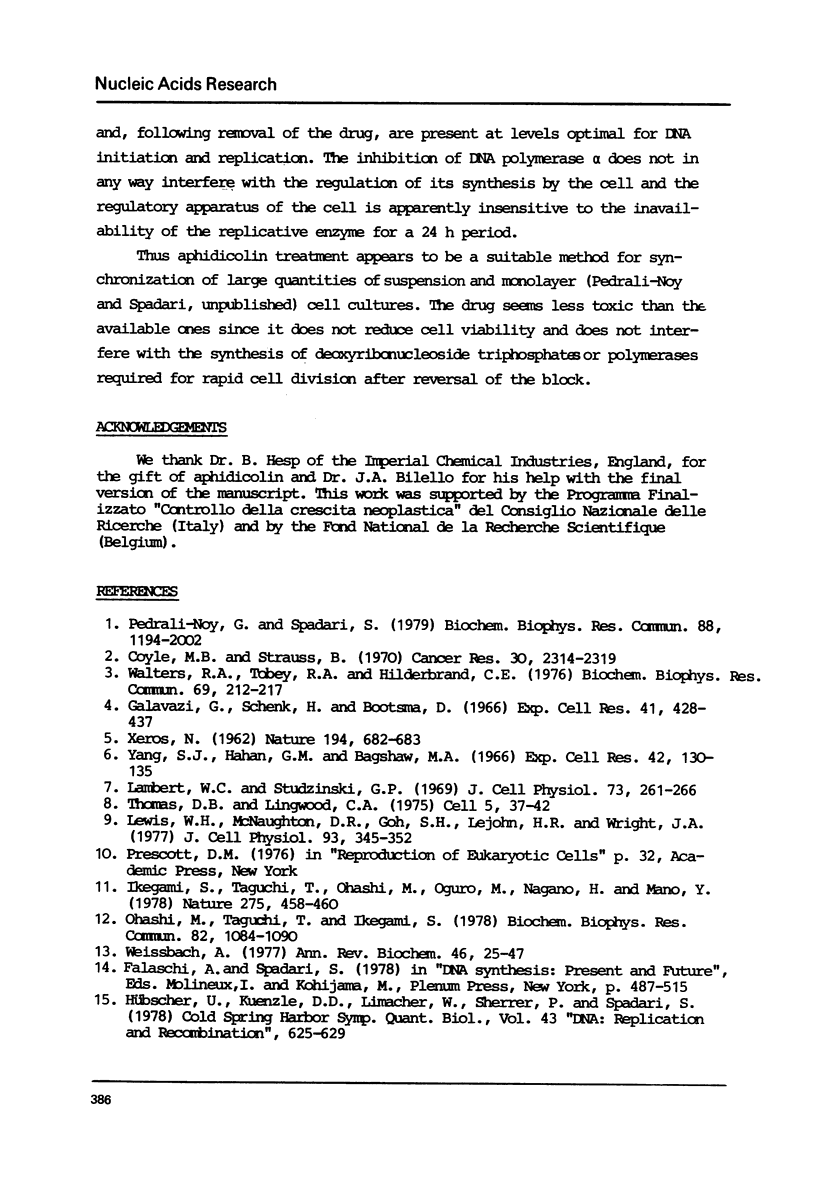
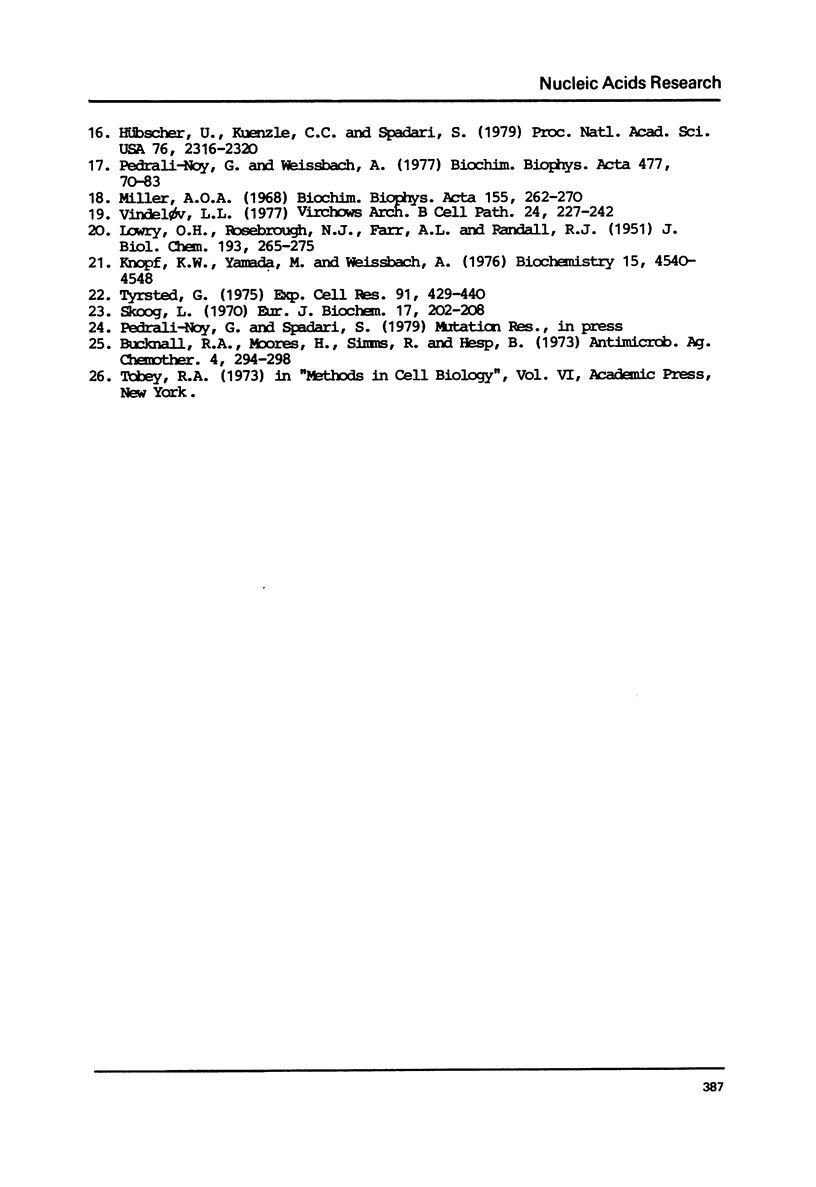
Selected References
These references are in PubMed. This may not be the complete list of references from this article.
- Bucknall R. A., Moores H., Simms R., Hesp B. Antiviral effects of aphidicolin, a new antibiotic produced by Cephalosporium aphidicola. Antimicrob Agents Chemother. 1973 Sep;4(3):294–298. doi: 10.1128/aac.4.3.294. [DOI] [PMC free article] [PubMed] [Google Scholar]
- Coyle M. B., Strauss B. Cell killing and the accumulation of breaks in the DNA of HEp-2 cells incubated in the presence of hydroxyurea. Cancer Res. 1970 Sep;30(9):2314–2319. [PubMed] [Google Scholar]
- Galavazi G., Schenk H., Bootsma D. Synchronization of mammalian cells in vitro by inhibition of the DNA synthesis. I. Optimal conditions. Exp Cell Res. 1966 Feb;41(2):428–437. doi: 10.1016/s0014-4827(66)80149-0. [DOI] [PubMed] [Google Scholar]
- Hübscher U., Kuenzle C. C., Limacher W., Scherrer P., Spadari S. Functions of DNA polymerases alpha, beta, and gamma in neurons during development. Cold Spring Harb Symp Quant Biol. 1979;43(Pt 1):625–629. doi: 10.1101/sqb.1979.043.01.069. [DOI] [PubMed] [Google Scholar]
- Hübscher U., Kuenzle C. C., Spadari S. Functional roles of DNA polymerases beta and gamma. Proc Natl Acad Sci U S A. 1979 May;76(5):2316–2320. doi: 10.1073/pnas.76.5.2316. [DOI] [PMC free article] [PubMed] [Google Scholar]
- Ikegami S., Taguchi T., Ohashi M., Oguro M., Nagano H., Mano Y. Aphidicolin prevents mitotic cell division by interfering with the activity of DNA polymerase-alpha. Nature. 1978 Oct 5;275(5679):458–460. doi: 10.1038/275458a0. [DOI] [PubMed] [Google Scholar]
- Knopf K. W., Yamada M., Weissbach A. HeLa cell DNA polymerase gamma: further purification and properties of the enzyme. Biochemistry. 1976 Oct 5;15(20):4540–4548. doi: 10.1021/bi00665a032. [DOI] [PubMed] [Google Scholar]
- LOWRY O. H., ROSEBROUGH N. J., FARR A. L., RANDALL R. J. Protein measurement with the Folin phenol reagent. J Biol Chem. 1951 Nov;193(1):265–275. [PubMed] [Google Scholar]
- Lambert W. C., Studzinski G. P. Thymidine as a synchronizing agent. II. Partial recovery of HeLa cells from unbalanced growth. J Cell Physiol. 1969 Jun;73(3):261–266. doi: 10.1002/jcp.1040730310. [DOI] [PubMed] [Google Scholar]
- Lewis W. H., McNaughton D. R., Goh S. H., LéJohn H. B., Wright J. A. Inhibition of mammalian ribonucleotide reductase by a dinucleotide produced in eucaryotic cells. J Cell Physiol. 1977 Dec;93(3):345–352. doi: 10.1002/jcp.1040930305. [DOI] [PubMed] [Google Scholar]
- Miller A. O. Etude par sédimentation en gradient de sucrose de la ferritine marquée au 59Fe, extraite de cellules de HeLa. Biochim Biophys Acta. 1968 Jan 29;155(1):262–270. [PubMed] [Google Scholar]
- Noy G. P., Weissbach A. HeLa cell DNA polymerases: the effect of cycloheximide in vivo and detection of a new form of DNA polymerase alpha. Biochim Biophys Acta. 1977 Jul 5;477(1):70–83. doi: 10.1016/0005-2787(77)90161-7. [DOI] [PubMed] [Google Scholar]
- Ohashi M., Taguchi T., Ikegami S. Aphidicolin: a specific inhibitor of DNA polymerases in the cytosol of rat liver. Biochem Biophys Res Commun. 1978 Jun 29;82(4):1084–1090. doi: 10.1016/0006-291x(78)90298-x. [DOI] [PubMed] [Google Scholar]
- Pedrali-Noy G., Spadari S. Effect of aphidicolin on viral and human DNA polymerases. Biochem Biophys Res Commun. 1979 Jun 27;88(4):1194–1202. doi: 10.1016/0006-291x(79)91106-9. [DOI] [PubMed] [Google Scholar]
- Skoog L. An enzymatic method for the determination of dCTP and dGTP in picomole amounts. Eur J Biochem. 1970 Dec;17(2):202–208. doi: 10.1111/j.1432-1033.1970.tb01154.x. [DOI] [PubMed] [Google Scholar]
- Thomas D. B., Lingwood C. A. A model of cell cycle control: effects of thymidine on synchronous cell cultures. Cell. 1975 May;5(1):37–42. doi: 10.1016/0092-8674(75)90089-6. [DOI] [PubMed] [Google Scholar]
- Tyrsted G. The pool size of deoxyguanosine 5'-triphosphate and deoxycytidine 5'-triphosphate in phytohemagglutinin-stimulated and non-stimulated human lymphocytes. Exp Cell Res. 1975 Mar 15;91(2):429–440. doi: 10.1016/0014-4827(75)90124-x. [DOI] [PubMed] [Google Scholar]
- Vindelov L. L. Flow microfluorometric analysis of nuclear DNA in cells from solid tumors and cell suspensions. A new method for rapid isolation and straining of nuclei. Virchows Arch B Cell Pathol. 1977 Aug 10;24(3):227–242. [PubMed] [Google Scholar]
- XEROS N. Deoxyriboside control and synchronization of mitosis. Nature. 1962 May 19;194:682–683. doi: 10.1038/194682a0. [DOI] [PubMed] [Google Scholar]
- Yang S. J., Hahn G. M., Bagshaw M. A. Chromosome aberrations induced by thymidine. Exp Cell Res. 1966 Apr;42(1):130–135. doi: 10.1016/0014-4827(66)90326-0. [DOI] [PubMed] [Google Scholar]


